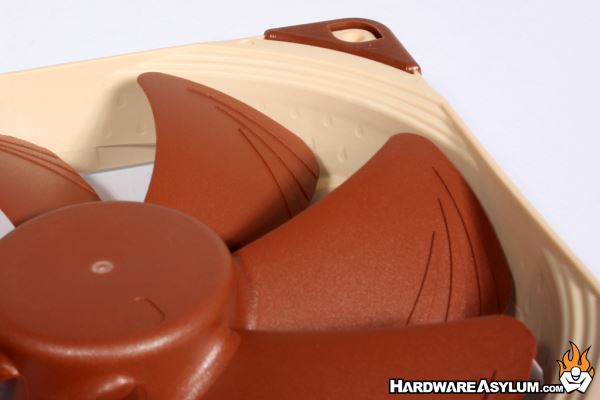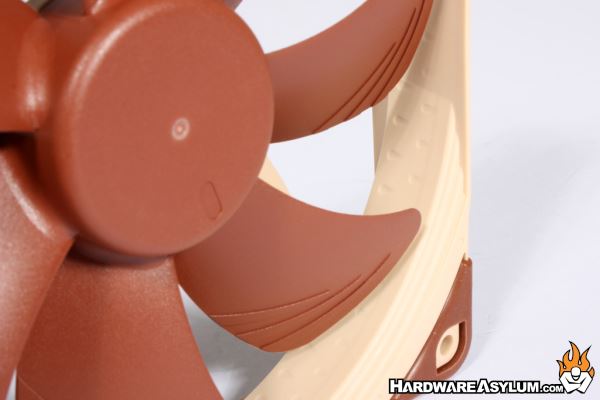Noctua NF-A14 FLX and ULN 140mm Case Fan Review
Author: Dennis Garcia
Published: Friday, May 03, 2013
Noctua Fan Technology
The first feature found on the NF-A14 is the rubber pads located on each of the fan corners. These are called the Integrated Anti-Vibration Pads and are designed to isolate fan vibrations while still maintaining a standard mounting structure.
Moving inward you will begin to notice some features of the NF-A14 starting with the steps you see along the outer lip. These are called the Stepped Inlet Design and help to reduce air turbulence as it enters the fan. Doing so will reduce overall noise and increase suction when space is limited.
Moving inward you will begin to notice some features of the NF-A14 starting with the steps you see along the outer lip. These are called the Stepped Inlet Design and help to reduce air turbulence as it enters the fan. Doing so will reduce overall noise and increase suction when space is limited.

Below the steps and looking on the inner wall of the fan you'll find a series of divots at regular intervals. These are the Inner Surface Microstructures. Much like how a golf ball is more aerodynamic with dimples so is this fan. As the blades spin they will hover over the boundary layer and spin with less resistance increasing overall efficiency and lowering noise.
Blade Geometry is similar to what can be found on the NF-F12 focused flow fan with the addition of Flow Acceleration Channels located on the trailing edge of the fan blade. These channels work on another boundary layer principle where air will tend to vortex behind the fan blade similar to what happens at the tips of airplane wings. By adding these acceleration channels the air turbulence is minimized which in turn increases airflow and further reduces excess noise.
Blade Geometry is similar to what can be found on the NF-F12 focused flow fan with the addition of Flow Acceleration Channels located on the trailing edge of the fan blade. These channels work on another boundary layer principle where air will tend to vortex behind the fan blade similar to what happens at the tips of airplane wings. By adding these acceleration channels the air turbulence is minimized which in turn increases airflow and further reduces excess noise.

Then fan blades themselves feature a slightly rough texture and smooth edges on both leading and trailing blade edges. Each of the fan tips are rounded to prevent injury and also speaks to the attention to detail present in all Noctua products.
The single biggest failure point on any fan is the bearing. We remember back in the early days when old fans needed to be greased up after the bearing wore out. Thankfully bearing technology has advanced beyond this into something like the SSO or Self Stabilizing Oil Pressure bearing found on the newest Noctua fan designs. Both the ULN and FLX A14 fans come with a second generation SSO bearing that places the magnet closer to the spindle shaft to increased torque and provide better stabilization.
The single biggest failure point on any fan is the bearing. We remember back in the early days when old fans needed to be greased up after the bearing wore out. Thankfully bearing technology has advanced beyond this into something like the SSO or Self Stabilizing Oil Pressure bearing found on the newest Noctua fan designs. Both the ULN and FLX A14 fans come with a second generation SSO bearing that places the magnet closer to the spindle shaft to increased torque and provide better stabilization.

